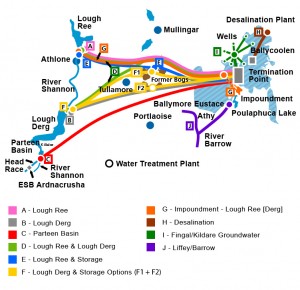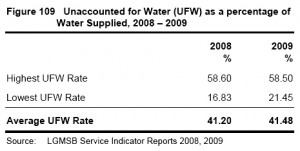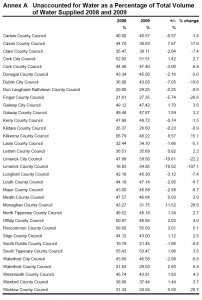2010-04-01: The Inter-Basin Water Transfer Project from Lough Ree, on the River Shannon, to Dublin City, in Ireland, has been described as a Pilot Adaptation Project on the United Nations Framework Convention on Climate Change (UNFCCC) WebSite Database relating to the Nairobi Work Programme (2005-2010).
I did not imagine this … please check out the listing, for yourselves, on this WebPage … www.unfccc.int/adaptation/nairobi_work_programme/knowledge_resources_and_publications/items/4555.php?sort=focus_sort&dirc=DESC&seite=1&anf=0&type=®ion=&focus=&means=
Detailed information concerning the Project can be accessed and downloaded at this Irish Address: www.watersupplyproject-dublinregion.ie It will cost approximately €600 million (probably much more !) … devour many material resources and have an adverse environmental impact … the objective being to divert water from the Shannon, a large river in the mid-west of the country … to Dublin, the capital city, which is located over 100 kilometres away on the east coast … in order to deal with the expected shortage of water which will be caused, among other relevant factors, by future climate change.
.

.
BUT … just how Sustainable is this Climate Change Adaptation Project … if the following other relevant factors are considered ?????
1. Since the 1960’s … a dysfunctional and corrupt Spatial Planning System in the Dublin City Region has actively encouraged an uncontrolled, urban and suburban horizontal sprawl to take place. Today, this pattern of development remains unchecked.
2. At this time, there are still no Residential Water Charges in Dublin. The concept of water conservation is, therefore, almost unknown among householders. National and local politicians are terrified by any prospect of having to vote in favour of imposing these necessary charges.
3. There are enormous un-intended losses, i.e. Leaks, from the public mains potable/drinking water distribution system … approximately 40% even in the good times, and recently, well in excess of 60% following the National Snow Emergency in Ireland.
4. Potable/drinking water supplied to houses in the Dublin City Region is not yet Metered. There is no urgency, therefore, in locating and repairing water leaks which occur between the private property boundary of a house and the house itself.
5. There is no existing legal requirement in Ireland’s National Building Regulations to Harvest Rainwater in any buildings, or on any hard surfaces in the vicinity of those buildings. A current proposal to amend Technical Guidance Document H: ‘Drainage & Waste Water Disposal’ will merely present relevant guidance text to building designers concerning this option.
Furthermore, there is no effective System of Technical Control operated by the Local Authorities in the City Region … to enforce a legal requirement concerning rainwater harvesting … even if such a legal requirement were to be introduced !
6. In 2005-2006, at the height of the Celtic Tiger Economic Boom … the existing Foul and Storm Water Drainage Infrastructure in the City Region was already stretched to keep pace with the ‘wild’ demands for new development land. Detailed information concerning the Greater Dublin Strategic Drainage Study can be accessed and downloaded at this Irish Address: www.dublincity.ie/WaterWasteEnvironment/WasteWater/Drainage/GreaterDublinStrategicDrainageStudy/Pages/RegionalDrainagePolicies-OverallPolicyDocument.aspx
Overloading of the existing drainage systems was evident from a marked deterioration in water quality, increased risks of flooding and pollution, and concerns that the drainage system and sewage treatment plants had insufficient capacity to cater for future development.
7. Sustainability Impact Assessment (SIA) …
‘ a continual evaluation and optimization assessment – informing initial decision-making, or design, and shaping activity/product/service realization, useful life and termination, or final disposal – of the interrelated positive and negative social, economic, environmental, institutional, political and legal impacts on balanced and equitable implementation of Sustainable Human & Social Development ‘
… is not yet a standard procedure, at any level, within national, regional and local Authorities Having Jurisdiction (AHJ’s). If it were, the most glaring flaw in this project would rapidly be identified. There is no comprehension at all, in the minds of Dublin City’s decision-makers, that water is a very valuable, but limited, resource !
.
Although today is 1st April 2010 … far too many people in senior policy and decision-making roles are giving solemn, unquestioning consideration to this Project.
To be successful, however, National Adaptation Strategies, Programmes and Projects must be informed, in a meaningful way, by the concept of Sustainable Human and Social Development … and, prior to implementation, must be filtered through the lens of a comprehensive Sustainability Impact Assessment (SIA) !
.
.
POSTSCRIPT
2011-09-29: Relevant extract from the 2010 Annual Report of the Irish Comptroller and Auditor General – Volume 2 …
WATER SERVICES EFFECTIVENESS
22.11 Funding for the provision of infrastructure for the supply of drinking water is provided by the Department of the Environment, Community and Local Government under two programmes. Major water supply schemes are included in the rolling three-year Water Services Investment Programme (WSIP). These schemes focus on the larger concentrations of population in urban areas. Annual Rural Water Programmes (RWP) provide the bulk of funding for the construction of group water schemes and small public schemes in rural areas.
22.12 Over the period 2000-2010, €5.2 Billion of Exchequer resources have been invested in the upgrading and provision of new water services infrastructure, of which €4.2 Billion was spent on WSIP and €0.99 Billion was spent on RWP. Overall expenditure includes investment of over €1 Billion on public water supply and networks and €168 Million on water conservation. [The WSIP expenditure also includes €889 million relating mainly to the group water sector under the rural water programme.] There are two key indicators of the effectiveness of expenditure on water supply and conservation:
- the quality of drinking water;
- the extent to which treated water reaches the consumer.
.
Effectiveness of Water Supply System
22.17 Loss of output is a feature of all water distribution systems. Unaccounted for Water (UFW) is a measure that is used to track this loss. It is the difference between ‘net production’ which is the volume of water delivered into a network and ‘consumption’ measured in terms of the volume of water that can be accounted for by legitimate consumption.
22.18 Figure 109 shows UFW as a percentage of the net volume of water supplied for 2008 and 2009. It sets out the national average performance and the range across local authorities. Annex A contains the data on UFW for these two years for all county and city councils.
.

.

.
22.19 Overall, the average percentage of UFW was approximately 41.48% in 2009, which showed a marginal increase over 2008 (41.20%). Some 17 of the 34 authorities have seen an improvement in 2009, the most noticeable being a reduction in the percentage of water lost in Monaghan which was down by 27%, Cavan by 18% and Kilkenny by 15%. The other 17 local authorities reported a disimprovement in the amount of UFW for 2009, with Limerick County Council reporting losses of 35%, up from 17% in 2008. Fingal County Council, Limerick City Council, and Dublin City Council reported substantial increased leakage in 2009 over 2008 at 27%, 22% and 20% respectively.
Cost of Unaccounted for Water (UFW)
22.20 The cost of UFW is considerable for local authorities. However, since the LGMSB does not collate information on water production and associated costs the data is not available in the Department of the Environment, Community and Local Government. As a result, it is not possible in this report to provide an up-to-date estimate of the cost of UFW being experienced.
22.21 A value for money examination carried out in the mid-1990’s on water production and distribution showed that the cost per cubic metre of water produced varied between €0.14 to €0.39. The study found that overall water leakage level in the authorities surveyed at that time ranged from 27% to 40% of total water produced.
22.22 The results of the study were based on estimates since none of the authorities that were the subject of the value for money examination had the means to measure accurately the level of overall leakage.
22.23 Based on its results, the examination reported that, for five local authorities reviewed at that time, the estimated annual production cost of the water lost due to leakages was in the order of €3.5 million. Applying the Consumer Price Index to this value brings the cost to approximately €5.3 million in present-day terms.
22.24 As leakage is just one factor contributing to UFW, it appears from the losses now being recorded by local authorities that there has been little, if any, improvement in the situation despite the considerable State investment in water services in the interim.
Views of the Accounting Officer
22.25 The Accounting Officer informed me that under the National Water Conservation Sub-Programme, which commenced in 1996, the National Water Study undertook a comprehensive national water audit of all urban centres with populations exceeding 5,000 to determine the extent of UFW and leakage problems nationally. The National Water Study examined the reasons for UFW and set out recommendations to reduce the levels of UFW.
22.26 Arising from the findings of the National Water Study and pilot water conservation schemes undertaken in the main urban centres of Dublin, Cork, Galway, Waterford and Limerick, water conservation strategies and operational programmes were adopted which have been rolled out nationally since 2003.
22.27 The Dublin Region Water Conservation Programme, which was carried out between 1998 and 2002 as one of the pilot schemes under the National Water Conservation Sub-Programme, reduced regional leakage from 47% to 28%. UFW in the Dublin region now averages 30% which is amongst the lowest in the country.
22.28 Since the commencement of the water conservation sub-programme, substantial investment has been made in the fundamental infrastructure for water management, including the metering of supply input. Also, the methodology has been standardised. Arising from this, the reported figures now have an accuracy that the figures from earlier times could not have had.
22.29 By way of example, the Greater Dublin Water Supply Strategic Study (1996) estimated losses of 44% of total input, of which 39% was allocated to distribution losses and 5% allocated to customer losses. When the metering infrastructure was checked and upgraded during the water conservation project (around 2000), it was found that the original meter readings for flow into supply were incorrect, and that losses were actually higher than originally thought (giving the corrected estimate for that time of 42% distribution losses and 47% in total). Notwithstanding that the Dublin Region bulk metering infrastructure was considered reliable at the time, it was found to have inaccuracies that were subsequently corrected.
22.30 In terms of comparisons, the Accounting Officer pointed out that the Dublin supply is hugely significant, serving approximately one third of the population of the country. Consequently, the Dublin supply region reduction of distribution loss from 42% to 30% currently must reflect positively on the national average (and it is the corrected Dublin Region figure from 1995/96 that is most reliably reflective of the situation at that time).
22.31 A further observation by the Accounting Officer was that without investment the leakage situation will deteriorate as assets age. It follows that a certain level of investment is required even just to maintain the status quo.
22.32 The Accounting Officer stated that, outside of Dublin, most of the investment had been in water management systems, which while they had made a contribution to tackling leakage, were really the platform for the more intensive investment being rolled out for mains rehabilitation in the WSIP 2010-2012. She said that this investment in water management systems had contributed to greater efficiency in the supply system, which had been demonstrated during the two severe winters and flooding in Cork, when authorities had been better able to manage the rationing of supply and restoration of supply than they would have been a decade ago.
22.33 Finally, the Accounting Officer said that the need to focus on water conservation had been demonstrated through the development of service indicators, training in water conservation, development of guidance and work with the County and City Managers Association to streamline the approaches and accelerate work in this area.
CONCLUSION – Effectiveness of Water Supply System
UFW arises from factors such as leakage, poor service connections and metering errors. Average UFW levels in Ireland appear to be at levels twice the OECD average of 20%. While some caution needs to be applied in interpreting the results of a limited examination of water leakage carried out over 15 years ago, present-day losses may be, in many local authorities, as high as those found in the mid-1990’s, notwithstanding an investment of over €1 Billion in water supply and conservation in the last ten years.
In the light of the potential cost of UFW it is necessary that the factors that give rise to UFW be reviewed and strategies and operational programmes to address the underlying issues contributing to the problem be re-evaluated.
.
.
END
